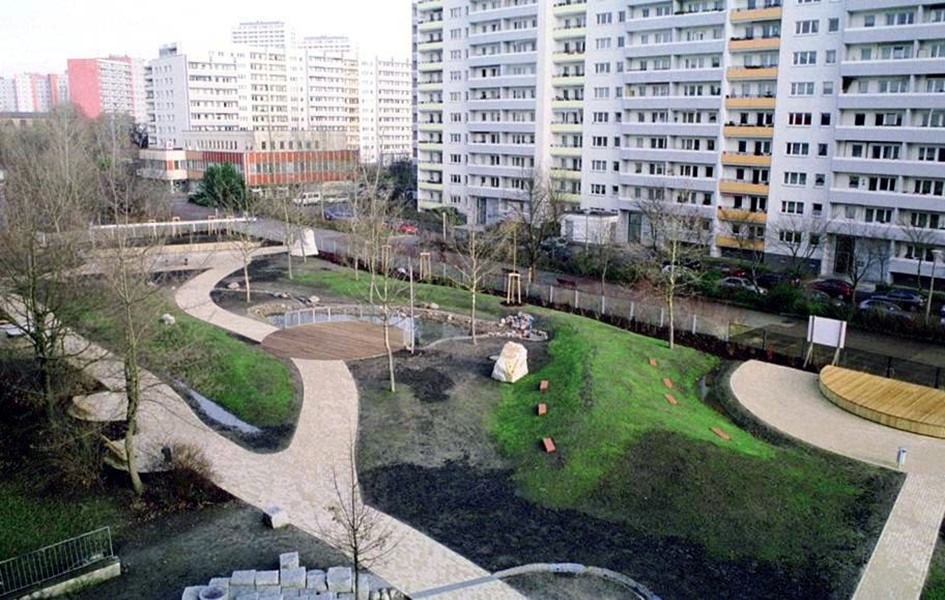Integrated rainwater management at schools

Lichtenberg Grammar School
The importance of green spaces for the cognitive development and concentration of pupils is undisputed. Nature-based schoolyards with greenery, water and a high quality of stay have a tremendously positive impact on learning.
Green spaces not only offer a relaxing retreat, but also promote creativity, attention and the mental well-being of pupils. A completely new and varied landscape was created by unsealing concrete and asphalt, creating hills, ponds, pools and watercourses as well as high-quality greenery. Together with the pupils’ sculpture project, an inspiring environment was created with which the pupils not only identify, but which also contributes significantly to their well-being.
The ecological upgrading also includes the use of rainwater for toilets, which was also installed in the building as part of a line renewal. This includes pressure boosting systems and a second pipe system. Rainwater from the school roof and gymnasium is collected in 2 cisterns, fed into the building and pumped from there to the toilets.

School at Schäfersee
Watercourses are like lifelines that flow through the landscape and bring life to every corner. This principle was also applied here.
In addition to the task of transforming dull and functionless schoolyards into beautiful and functional ones, it has always been the sustainability aspect that drives schoolyard designs. This means that economy, ecology and social aspects must come together. From an economic point of view, schoolyard designs with rainwater disconnection from the sewage system make a lot of sense, as the rainwater charge can then be waived. A not insignificant factor at € 10,000 – 15,000 per year and school! And from an ecological and social point of view, “rainwater schoolyards” also offer enormous advantages: they offer lively recreational opportunities, play and sport, but also groundwater recharge, drinking water savings and garden irrigation with rainwater.
At this school, 200 m of watercourses were redesigned and tiled by the children themselves; a pond was extended, underground pipes and shafts renewed, cisterns and pumps installed.

Christburg School
The schoolyard of this school in Prenzlauer Berg is not only small, but was also almost completely sealed. There were hardly any opportunities to play. As part of the redesign, the ground was unsealed, a large play area and a soccer pitch were created and a new fountain was built. In order to allow the children to play and run around more, the dividing wall was torn down with the consent of the owners of the neighboring property.
During the project week, in which 500 pupils helped to rebuild the schoolyard, around 40 children sat on the wall on the first morning; with spoons and forks they tried to tear it down! An unforgettable sight!
The theme of participation runs through the entire history of the office: whenever possible, users were involved in the planning and implementation of almost all construction projects right from the start. This not only encouraged creativity, but above all identification.
